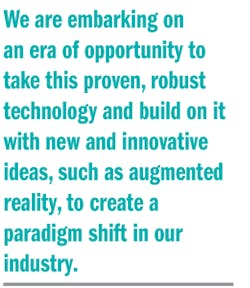This file type includes high-resolution graphics and schematics when applicable.
This year will likely be remembered as the summer of Pokémon GO, the cultural phenomenon that took our country by storm. If you didn’t get a chance to play, you probably noticed game users walking around with their eyes glued to their smartphones while also scanning their surroundings. Phones are the tools that help them navigate in their quest to catch Pokémon characters hiding in the midst of our own cities and neighborhoods. When a character appears on screen, players click on it and the Pokémon is there, digitally superimposed as if among us in the real world.
With Pokémon GO, augmented reality was finally at our fingertips and accessible to millions of people. But Pokémon GO is just one example of augmented reality—a live view of a physical, real-world environment whose elements are augmented (or supplemented) by computer-generated sensory input such as sound, video, graphics, or GPS data.
Although the glow of Pokémon GO faded by Labor Day, the app has sparked conversations about the potential benefits of augmented-reality technology across many industries. Where Pokémon GO was a fun summer fad, in the world of mobile and industrial equipment, can augmented reality be used to provide easier access to meaningful information? Absolutely. Can the same technology that captivated people of all ages over the summer help end users from construction to steel production visualize the health of their machines? Sure thing.
Now consider the benefits an augmented-reality app might have when it comes to efficiency for this factory. Instead of manually checking the valve or sorting through data, is there a way to view the machinery through an app—say, by pointing your phone’s camera at it—that provides actionable information on screen? Not yet, but it may be closer than you think. Vast potential benefits for end-users certainly exist, as illustrated by this simple example.
Fluid-power technology continues to be a proven and trusted workhorse. Incremental improvements will continue to occur, but profound changes in the fundamentals of fluid power are unlikely. We are embarking on an era of opportunity to take this proven, robust technology and build on it with new and innovative ideas, such as augmented reality, to create a paradigm shift in our industry.
Pokémon GO made augmented reality a reality—commonplace, even—and has sparked the creativity of innovative thinkers in our industry and across the many industries Eaton serves. Tremendous opportunity exists for this creativity to transform the world using new technologies, like augmented reality, to provide information and value—and maybe even have some fun.
David Strohsack is director of product management, Power and Motion Control Business, at Eaton Corp.
Got comments or opinions about augmented reality in fluid power? Join the discussion on Twitter at #augmentedreality to participate.





